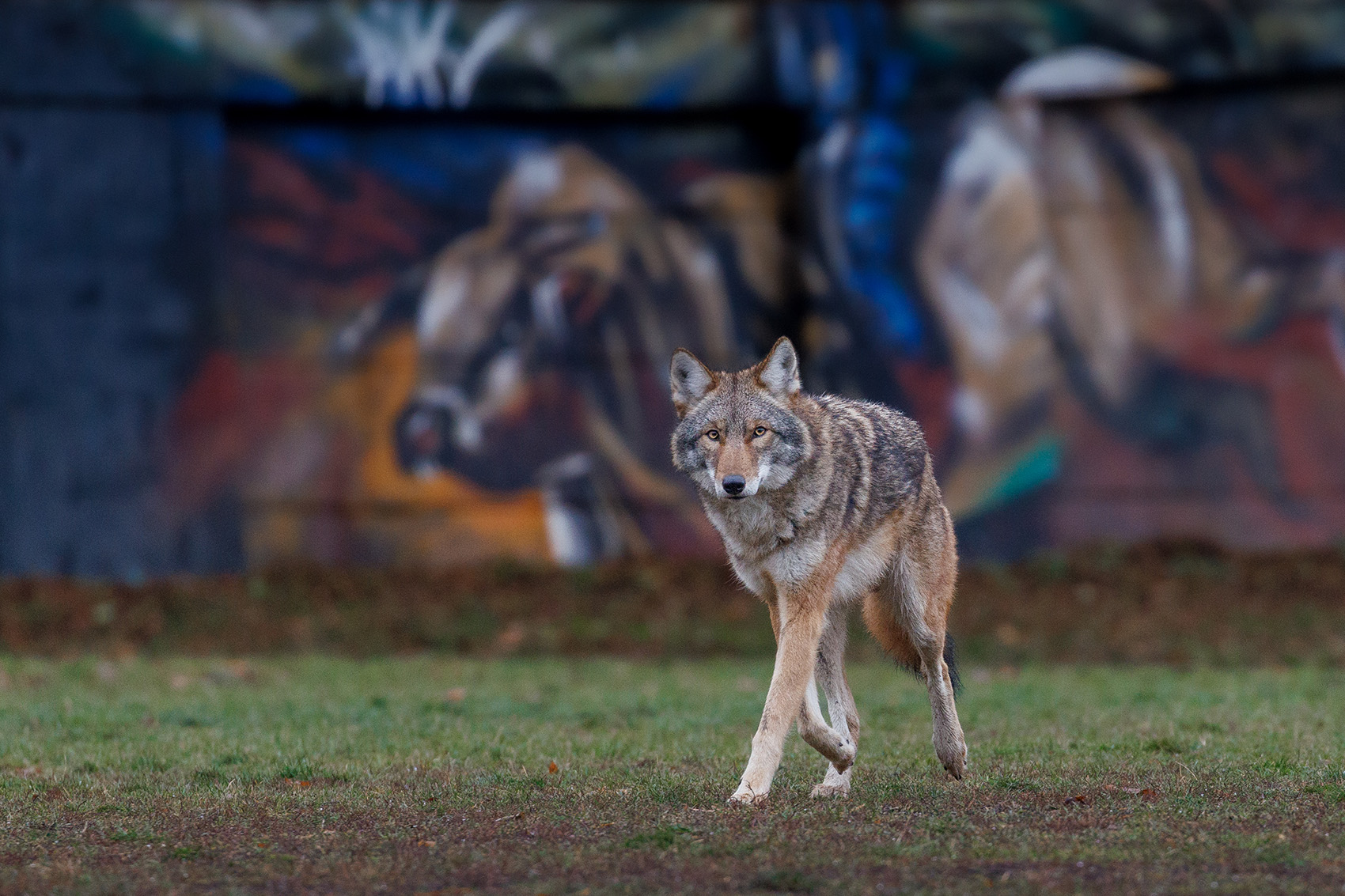To successfully catch a Canadian nightcrawler, you have to approach it a little like you’re a cat. The worm—fat, pink, undomesticable, and anywhere between five and 10 inches long—has made its way two-thirds out of its burrow, taking in moisture from the cool night air and exploring the surface of the soil for food. If it senses your approach, it will hurtle back into its hole with startling, uncharacteristic speed. So, crouched in the dirt, you must reach for it with a quiet, swift confidence. With the pads of your thumb and forefinger, you grasp the worm’s body right above where it disappears into the burrow hole. Gently, firmly, careful not to squish or tear it, you pull.
It’s just past 10 p.m. on a cool, overcast night in early July, and I’m standing in the middle of a field in the heart of southern Ontario farm country—West Perth, population 9,000. Dozens of workers quietly emerge from the three vans that have driven onto the field. In the dim light spilling out of the vehicle interiors, they layer raincoats over hoodies, bracing for the damp and the chill. Then, they accessorize: LED headlamps strapped to their foreheads, two bags of finely ground sawdust at their hips to keep their gloves or hands dry, and large, empty tin cans hooked at their waists. If it’s a good night, they will each harvest thousands, perhaps even 10,000, worms by dawn.

If you’re in the market for fishing bait anywhere in North America, and now even in parts of western Europe, odds are you’re buying a Canadian nightcrawler plucked from this stretch of land between Toronto and Windsor. These wild Canadian worms, who live so far beneath the surface of the soil that breeding or farming them is impractical, are hand-picked by a small army of workers, almost all immigrants from Southeast Asia, including generations of Vietnamese refugees and, more recently, temporary foreign workers from Thailand and Laos. It’s a niche sector of the western economy that’s exclusively sourced from this small corner of the province, and run primarily by family businesses passed from one generation to the next. In a given year, the more than $200 million industry sells between 500 and 700 million worms. But with changing demand, immigration labour policies, and the climate crisis, it’s also at an existential crossroads.
Join the thousands of Torontonians who've signed up for our free newsletter and get award-winning local journalism delivered to your inbox.
"*" indicates required fields
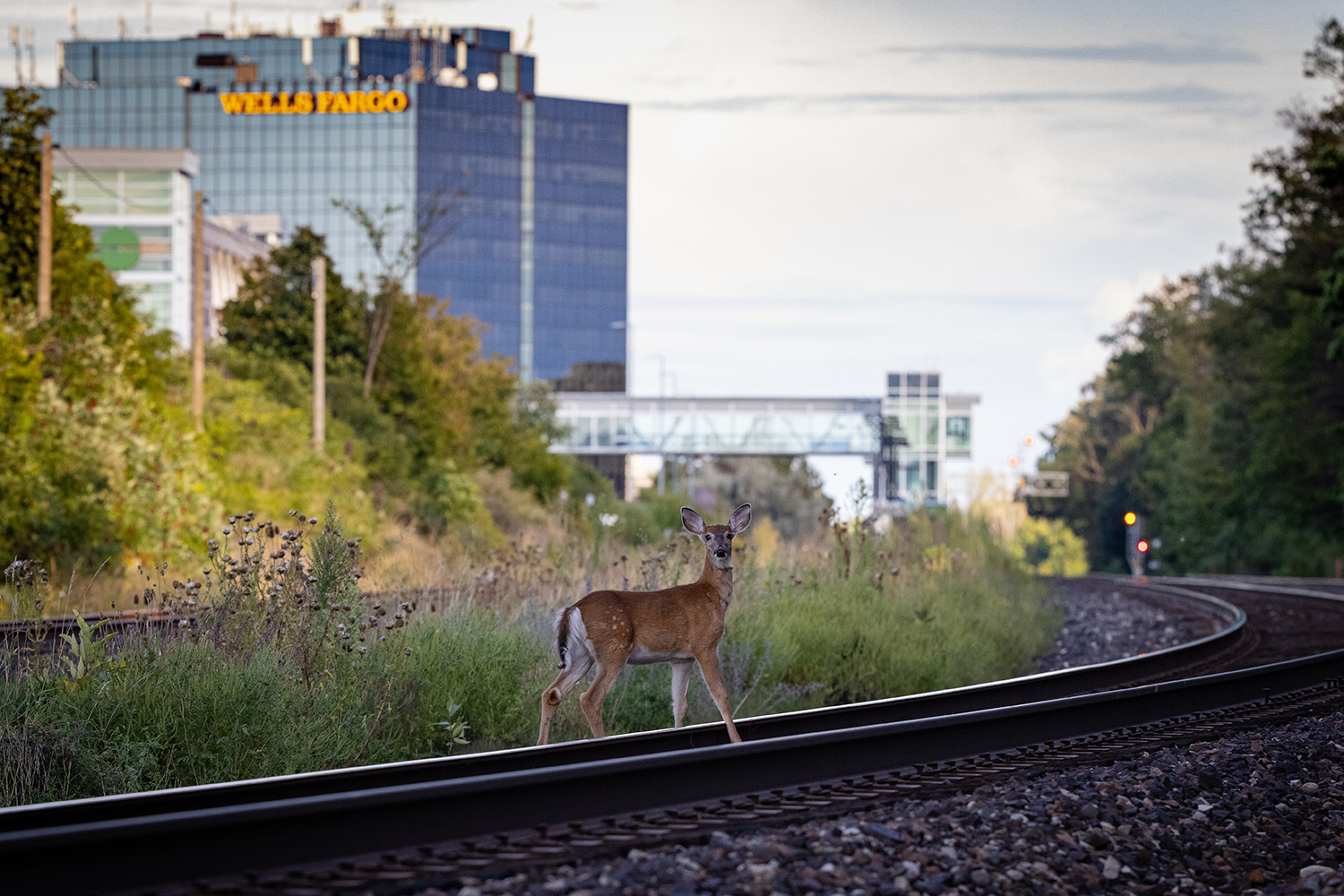
For months, since I learned of the industry, I’d been begging the local titans of worm commerce to let me tag along on a night of worm harvesting. Everyone I spoke to was skeptical about my willingness to pick worms. It’s gruelling work, kneeling over in a dark field, eyes trained to the ground for six or seven hours. It’s also very slimy: pickers dip their hands in sawdust every few worms, to dry off the mucilaginous residue the creatures leave on their (sometimes gloved) fingers. “You’re not scared, are you?” asked my editor-in-chief, who knew that I’d spent years making achingly slow progress on a serious bug phobia. But I’ve liked earthworms ever since I was a child, watching them appear on the playground after a heavy rain. What I’d read about the picking process sounded bizarre, ethereal—I needed to see it for myself.
I’d heard almost every rejection in the book—protecting proprietary business practices or the identities of workers, or having to get permission from the driver in charge of the workers, or just being too busy with the peak season around the July 1 and July 4 long weekends in Canada and the U.S. I was warned that the precarious, sometimes undocumented status of workers, or the industry’s inclination towards off-the-books cash transactions, would make it hard for me to get the access I was looking for. I had very nearly given up when I met Nick Alafogiannis, owner of A1 Bait.

Alafogiannis’s parents had once been in the worm business. “And they couldn’t afford babysitters,” he tells me, “so I was picking worms at 10 years old.”
By 12, he was helping out at the warehouse, and by 16, he was driving pickers out to the field to harvest worms. Now, close to 60, Alafogiannis is shaggy-haired and soft-spoken, with dark, kind eyes that turn down a little at the corners, giving him a permanently contemplative expression. He oversees the sale of more than 70 million worms a year. If I wanted to come pick worms, he said, that was no problem. All I needed to bring was a flashlight and some sensible shoes.
A week later, we’re an hour northwest of Kitchener, the sun having just set on rolling farmland dotted with horses and cows. July is the start of the low season for worms (it’s too hot for them to want to venture to the surface) but tonight Alafogiannis has two separate harvesting teams on two different farm plots, one 100 acres, the other 90 acres. He rents the fields—about 10 annually—for tens of thousands of dollars from farmers who agree to hold off on growing corn or alfalfa or hay for a year (though the year of rest is actually good for the soil, an opportunity to replenish its supply of nutrients). From there, Alafogiannis does a little bit of everything: chases storms to decide which fields have had enough rainfall to be harvested (worms love moisture), waters the fields that haven’t, mows them using $2 million worth of gargantuan farm equipment he shipped over from Europe, sees to the delivery of worms to his Scarborough factory and their packaging once on-site, and makes sure they’re kept alive and healthy sitting in the fridges during the slow months. “[Before,] it was a struggle because I was a one-man show,” he says. He credits the growth of the last seven or eight years to his son, Chris, now 30. “Without him, I wouldn’t be able to do it.”
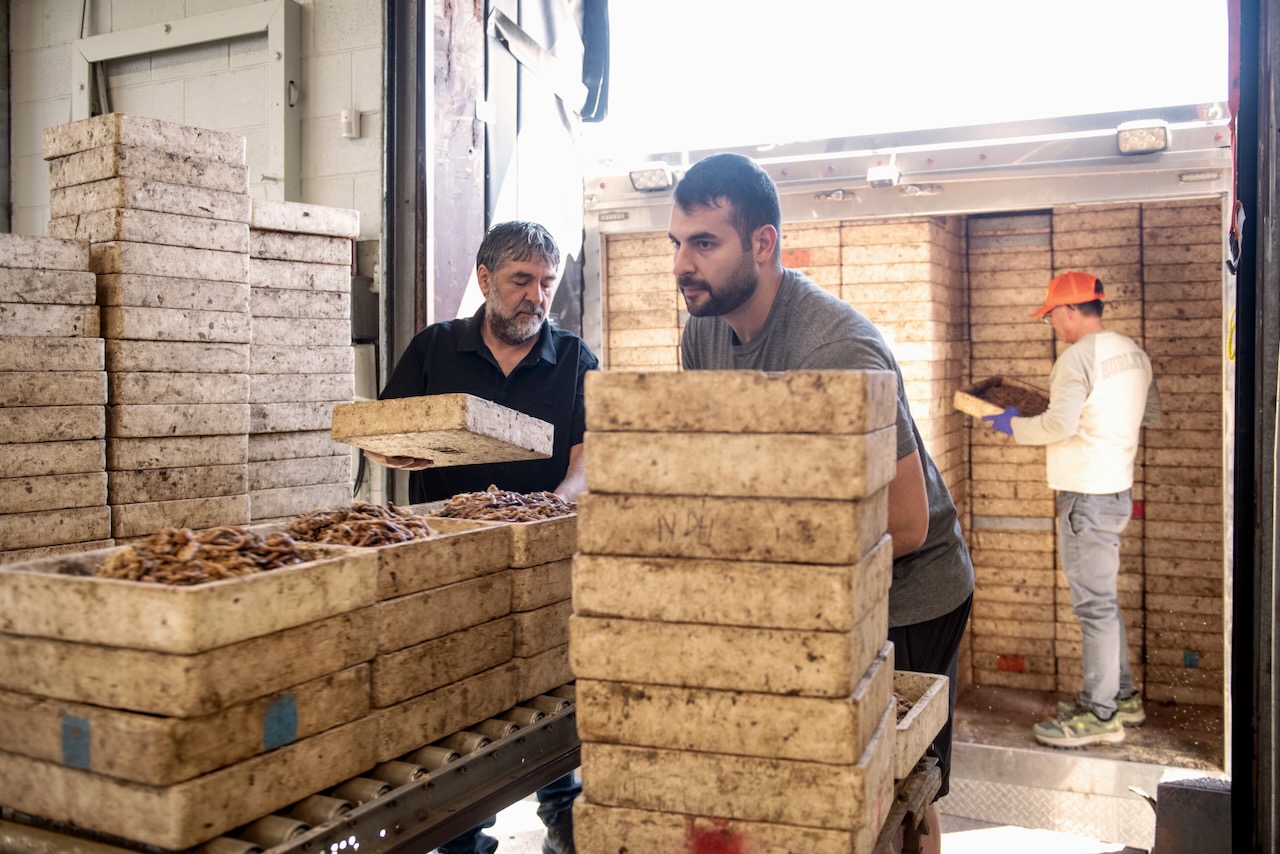
Every day, someone somewhere decides to open a restaurant or a retail store on their own. But it feels unlikely, and perhaps impossible, for anyone today to just get up and decide to open a worm business. “You can’t teach all these things in one sitting. It’s not that simple, it’s an art,” says Alafogiannis. “I’ll walk in the field and I’ll know if there’s worms in it or not. You won’t know. And that takes experience, and a lot of losses for you to learn that.”
There is something fantastical about making the teeming, untameable mass of worms writhing underfoot your life’s work. There’s very little you can do to foster good worm harvests, besides perhaps spraying down the field with manure and water. Until they’re in an industrial fridge somewhere, the worms are largely their own masters. It’s a business that demands understanding and falling into sync with something greater than—though literally, much smaller than—yourself.
As we make our way into the field, one of the drivers lends me a pair of neon orange latex gloves. My first hour in the field is spent alternating between scanning the ground with my flashlight, trying and failing to get a firm enough grip on the worms to pull them out of the dirt, and staring, awestruck, at the pickers as they work. The view is otherworldly: dozens of worm pickers working the land under the dim light of LED headlamps glowing red, instead of white, to ease the strain on the human eye and to avoid scaring off the worms. When you look at the field from a distance, against the backdrop of a pitch-dark country sky heavy with clouds, it feels a little like being on Mars, witnessing a colony of three-foot-tall, red glowing aliens scour through the dirt.
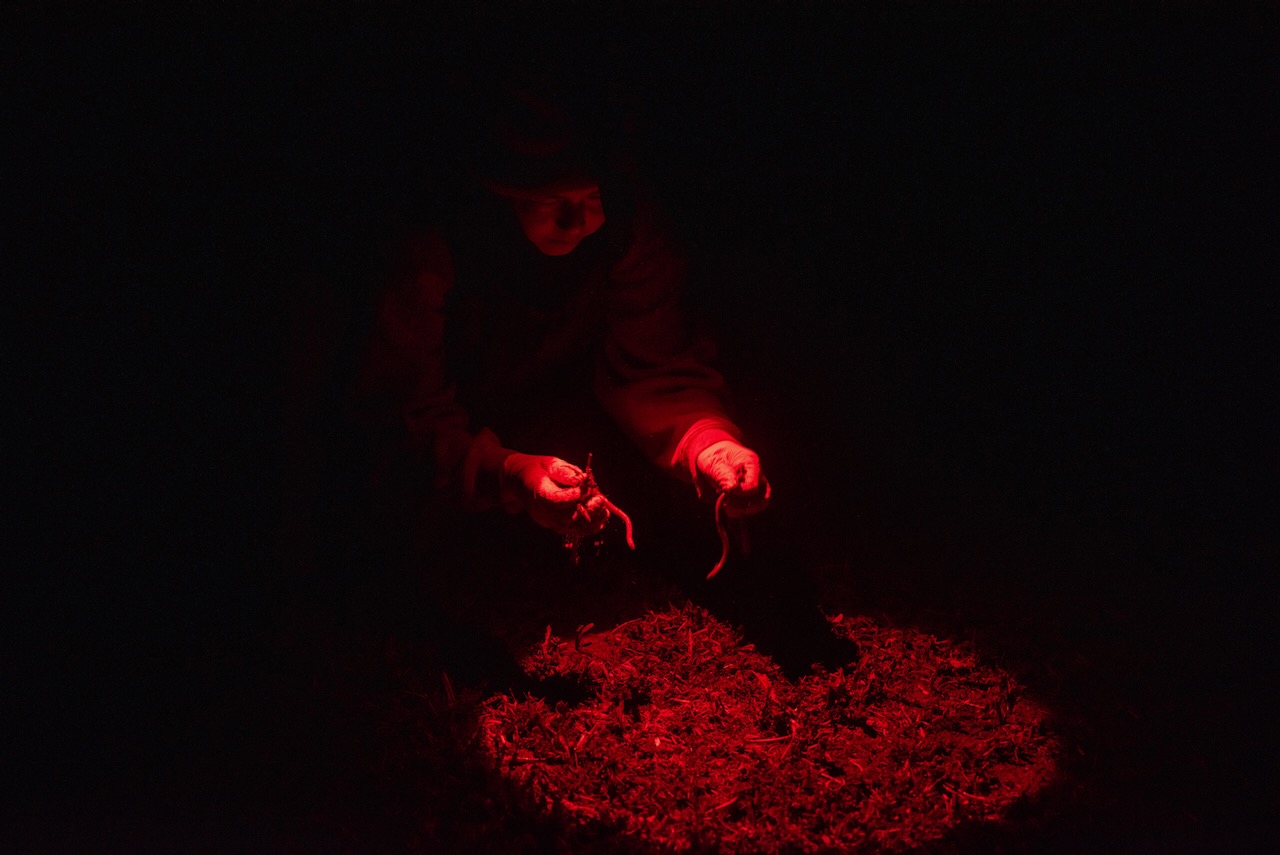
The pickers, about 60 to 70 of them at the 90-acre field, casually pull worms out of the ground with the outward ease of a practiced magician conjuring a rabbit from a hat. The worms aren’t there, and then suddenly they are, and once you start noticing them, all you can do is think about how many of them lay camouflaged in the dirt, sticking to the bottom of your shoes or to the tire treads of your car.
The landscape is quiet and still (worms hate wind, likely because it dries them out), occasionally broken by conversation between the van drivers. One picker quietly plays an old Adele song through the Bluetooth speaker hanging on his toolbelt, deftly pulling nightcrawlers from the ground despite the noise. I wonder for a moment if the worms like Adele.
My teacher in worm harvesting is Vatsana Sonethasack, a kindly middle-aged woman with an easy laugh, who first worked in the industry at age 16. A first-generation immigrant from Thailand via Laos, her parents worked briefly in worm picking as well. “When I was younger, in the ‘80s, I was the best,” she tells me. “No, bragging—I bought my first brand new car with picking worms.”
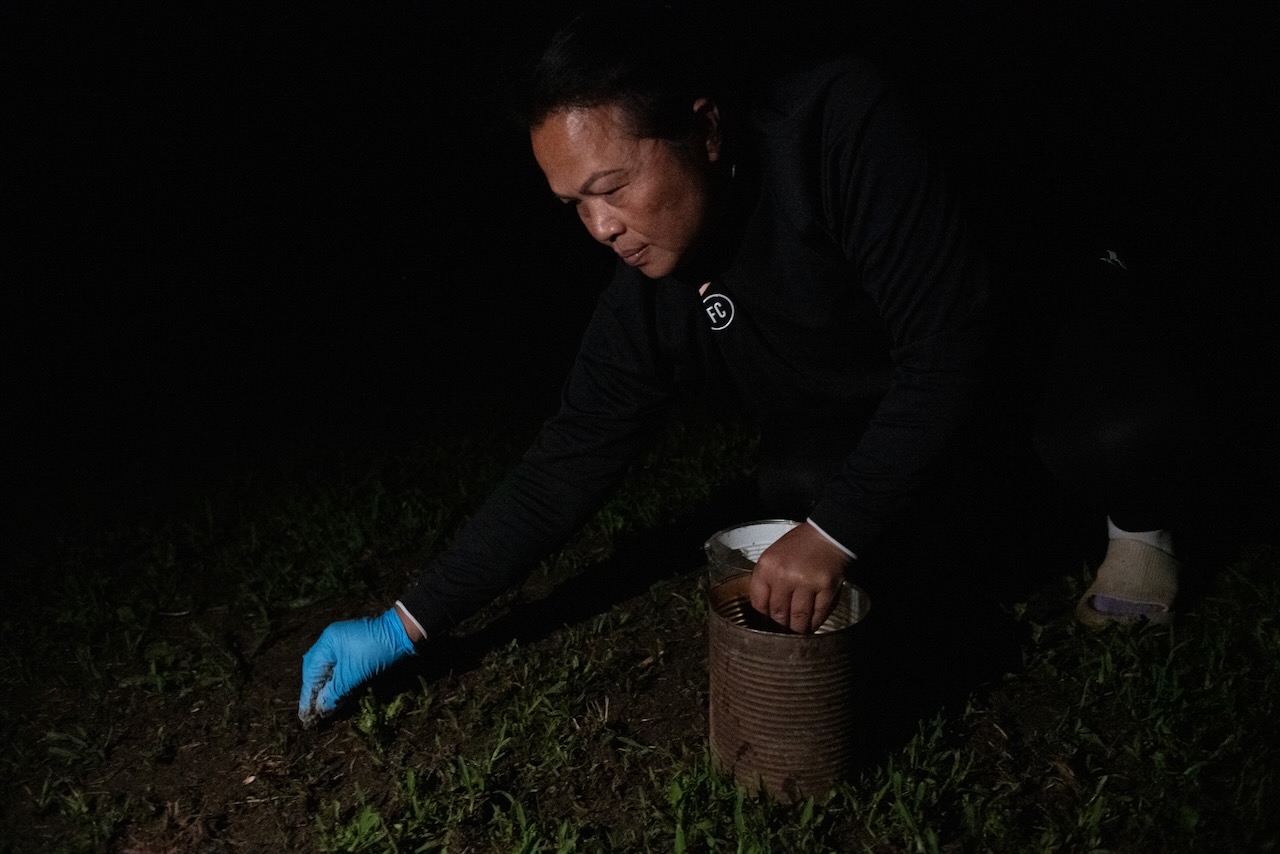
After two decades away from the field, Sonethasack returned as a manager for a small team of worm pickers, whom she hires from Thailand. (None of her workers speak English, and without an interpreter, I’m not able to speak with any of them directly, though some happily pose for photos.)
“I actually enjoy it,” she says of the work. “It’s really free. You have no one to control you. You can be yourself. You can work by yourself.”
We walk through the field together, picking spots to crouch in the dirt and pluck out some big, slow-to-react worms. She’s encouraging when I fail a half dozen times before I start to get a hold of the slimy wrigglers, careful not to tear them in half or pinch so hard as to cause a slow death. A tiny part of me had hoped to be almost supernaturally gifted at worm harvesting, some kind of agricultural Paul Atriedes capable of calling forth a “grandfather worm,” a particularly plump old specimen one distributor showed me, nearly as wide as a thumb. In reality, I pick maybe 20 worms in half an hour, then stop, defeated by an ache in back muscles I didn’t even know I had before this.
Canadian nightcrawlers are not, in fact, native to Canada. Tens of thousands of years ago, a glacier wiped out most of the earthworm population of northern North America. Today’s nightcrawlers were brought over by settlers from western Europe, likely burrowed into the soil of travelling plants and crops. From their first landing on North American soil, they were transported westward, “a journey that would have taken worms 1.5 million years if left to themselves,” writes Joshua Steckley, a Carleton University scholar on the Canadian worm industry.
Steckley is the voice on the nightcrawler industry. He literally wrote the book on it: the history of the industry, the sociocultural formation of recreational fishing, the establishment of the Canadian nightcrawler as the king of bait worms, the labour structure of the industry and its rich immigrant history. The first ever recorded mention of the Canadian nightcrawler—a marketing name, really, for the Lumbricus terrestris, dew worm, or earthworm—was only in 1902, he says, and the early bait worm industry was largely a side hustle by young boys looking to make a little spending money. It was only in the 1920s that people began hiring for the work, and only after the second World War, when fishing became a popular weekend leisure activity, that the industry really took off.
Canadian nightcrawlers, despite the name, can actually be found in the northern United States, as well. There were businesses in different pockets of North America harvesting worms at one time, Steckley explains. “Slowly but surely, they all kind of fade away, and it all consolidates in and around Toronto.”
Join the thousands of Torontonians who've signed up for our free newsletter and get award-winning local journalism delivered to your inbox.
"*" indicates required fields

Somehow, Ontario’s worm picking industry was uniquely successful. “You had ideal environmental conditions,” Steckley says, and a constant influx of cheap immigrant labour to the province. The workers arrived first from Europe—Greece (like the Alafogiannis family), Portugal, Hungary—and then in the ‘70s and ‘80s, from Vietnam and other parts of Southeast Asia. By the ‘80s, the local industry was dominated almost entirely by Vietnamese refugees, many of whom sent their children through university on the money they made picking worms, among other odd jobs. The saturation of the labour force with Vietnamese and other Southeast Asian workers is likely the result of the word-of-mouth hiring of friends, family, and acquaintances, though everyone I speak to seems to have a pet theory. A regional cultural history of rice planting, Sonethasack suggests, or a willingness to work in difficult conditions. Steckley reports one Vietnamese worker in the industry who described his community as being able to “see the value of the worm.”
There was a time decades ago when white college students and retirees looking to make some extra money would drop in to do the job intermittently, they both tell me. “Now if there’s any of those people left from the old days, they’d be miserable,” Alafogiannis says.
Attempts to recruit workers from other parts of the world—Mexico and India, for example, the largest contemporary providers of Canada’s foreign worker labour force—have been unsuccessful. On one occasion, Sonethasack hosted an earnest young Indian man who tried very hard to pick worms for two days, with little success, only to confess to her that he couldn’t do the job because as a vegetarian, he couldn’t bear the idea of hurting the worms. They still keep in touch.
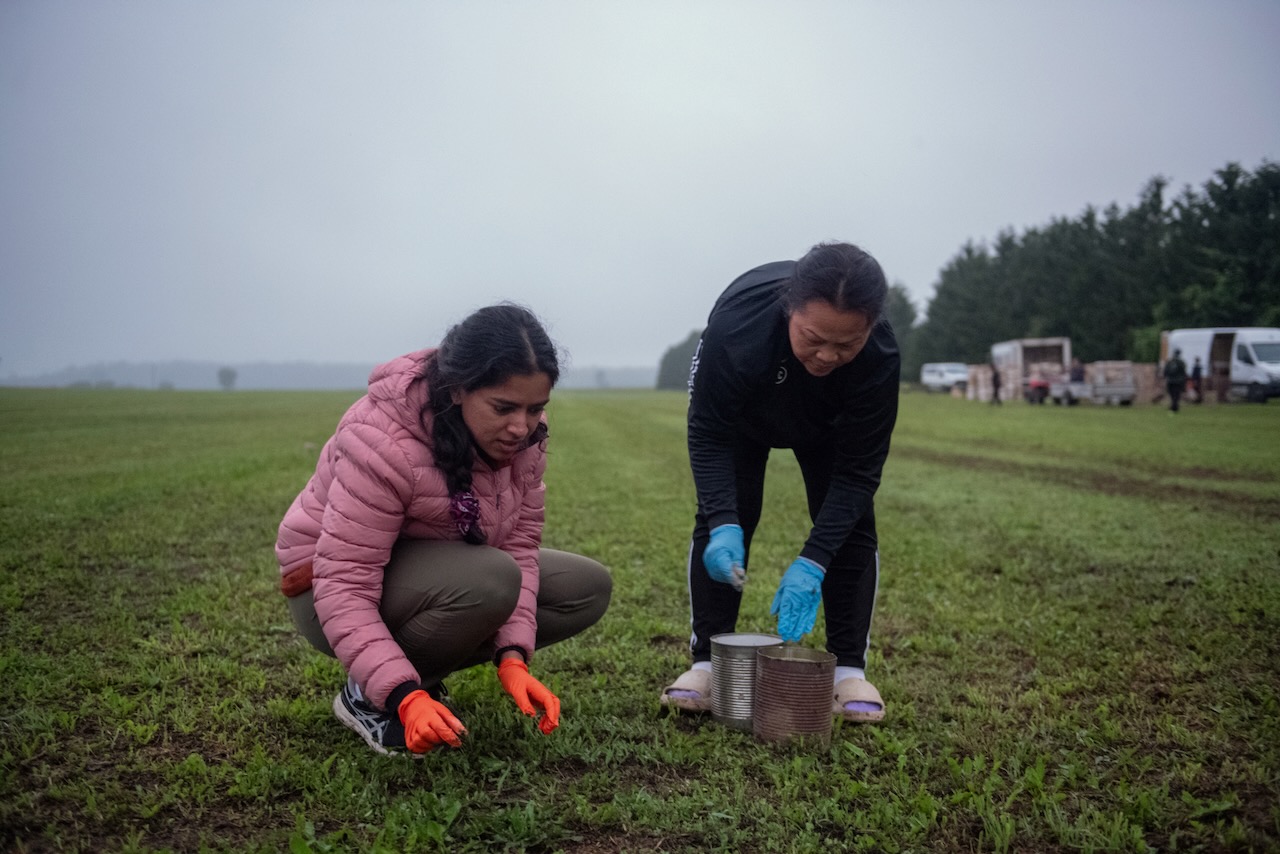
But all of the things that have made the nightcrawler industry in Canada what it is, and have allowed it to thrive for so long, now risk threatening the viability of its future.
A week before I went worm harvesting, I took a trip out to the rural exurbs of Hamilton, past the industrial lots and out to the border of farm country, where Mike and Davor Balac run Canada Live Bait Supply, a nightcrawler wholesaler exclusively exporting to the United States. When I arrived, the father and son duo were sitting out on the front porch of their family home; around the back, a warehouse housed tens of thousands of bait worms, nestled into dark peat moss in industrial-sized fridges.
Mike Balac, a strikingly spry, young-looking 79-year-old, first got into the worm business as a picker. “He’s born 1980, in January,” he says in a Serbian accent, pointing at his son. “My wife got no job. I got no job.” Interest rates were some of the highest they’d been in Canadian history, and they had a $20,000 mortgage on a home they were afraid they’d lose. A neighbour told him it’d be ok: just buy a van, and they’d get a group of people together to go out worm picking. Eventually, Mike drove down to the U.S. with a friend to start selling directly to bait shops. At each shop that agreed to buy from them, Mike would ask if there was another shop they could also reach out to. At the end of four days in the States, they’d accrued customers who collectively wanted 700,000 worms a week. They built up to meet the demand, then kept building, and kept building. Mike’s kids, much like Alafogiannis’s, got involved in the business young, helping package up worms for export at age five and six.
But the future of the business the Balacs have devoted their lives to is a big, murky haze beyond the next decade. Davor, 45, with a friendly, open face and tan lines where he’s squinted in the sun, says the demand is just not what it used to be. “The young people don’t want to fish—they fish, but they’re not diehard like [they] used to be.”
With more and more people living in urban centres—in Canada, rural population growth was 15 times slower than urban growth as of 2021—it’s fair to question whether fishing plays the same role in recreational culture that it did a generation ago. (I have been fishing exactly once, for an Ontario Parks Learn To Fish workshop during which I strongly suspect my mom, my best friend, and I all caught and released the same catfish, trapped in its own aquatic Groundhog Day.)

Everyone I spoke to also pointed out that worms aren’t a business that the next generation might be keen to take on, and it’s not a business you can easily sell off, if at all. Some of the retailers the Balacs used to sell to have retired and closed up shop, or died. Mike rattles off names like I’d know them—“Johnny in Memphis…Brad’s father…. Keith doesn’t want to take over…”—and there just aren’t new people replacing them. If the Balacs were in the pickleball business, it’d be a different story. But the fate of the Canadian nightcrawler industry is really a question of the fate of fishing as the great North American pastime, handed down from generation to generation.
More urgent still, Davor points out, is the matter of labour. It’s harder to find worm pickers now than ever before. “If there’s no pickers, who’s gonna pick the worms? If that goes away, this whole industry goes.”
Immigration restrictions and new limits on temporary foreign worker permits have made it difficult, tedious, and expensive to bring workers to Canada. And a tightening southern border—with newly instituted permit requirements to import worms, and a constant threat of tariffs—has made it trickier to sell to U.S. buyers.
Looming over all of the geopolitical and socio-economic factors shaping the worms industry is climate change. Steckley jokes that you’ll never find a climate skeptic in the worm industry: one Ohio worm seller I spoke to still recalls the drought of 1988—The Great Scorcher—which devastated farmland in southern Ontario and sent the price of worms skyrocketing. Today, Canada is experiencing a temperature rise at double the rate of the rest of the world. Hotter summer days, more torrential downpours and subsequent dry spells are a threat not only to the public’s inclination toward recreational fishing, and even the availability of fish, but to the worms themselves, who only come out in cool, damp, overcast conditions. If it’s too hot, or too cold, the worms suffer, and sellers like Alafogiannis and the Balacs are left waiting for rain.

The old saying goes that the early bird gets the worm. That’s because at dawn, worms mate. They sling themselves out of their burrows and their bodies almost fuse together, and they’re not quite as sensitive to the approaching footfall of a worm hunter. Sonethasack calls the mating pairs “doubles,” pinching them at the point they’ve fused together and drawing them up and into the can. I can’t seem to get the hang of this technique, instead grabbing each worm in one hand and holding them aloft, my hands like a crab’s claws. Any technique, I reassure myself, is better than none at all.
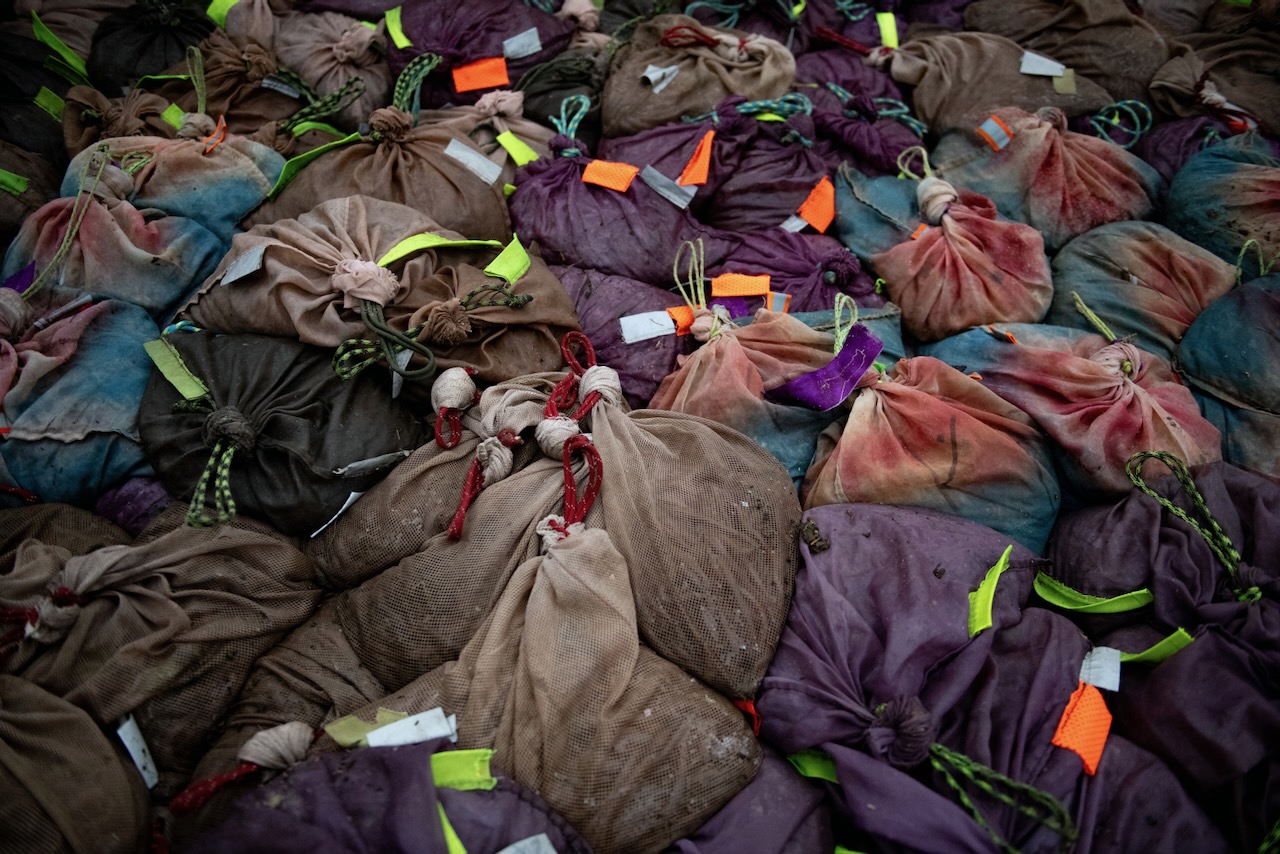
As the sky grows lighter, the field is shrouded in mist, and everything is damp. In the distance, red-winged blackbirds and song sparrows sing in the trees. “At the end of the night, [the workers] are like, gone. They’re ready to just lay down,” Sonethasack says. In spite of what I imagine are aching backs and legs, everyone is in high spirits. Two women laugh loudly, finally able to make noise after a night of being quiet for the worms. At the end of their shift, the workers each tally up the number of bags of worms they’ve harvested, and pack them into flat containers that will be taken to Alafogiannis’s warehouses, where the worms will live in a semi-hibernatory state in cold storage, until they’re ready to be sold and sent off to every corner of the U.S., or across the Atlantic Ocean back to the land of their ancestors. The workers will be back another day—perhaps the next night, if it’s not too hot, or the next time it rains—to continue the harvest, their headlamps pinpricks of light on a dark horizon, a mystery to anyone lucky enough to drive past them on a dark country road.
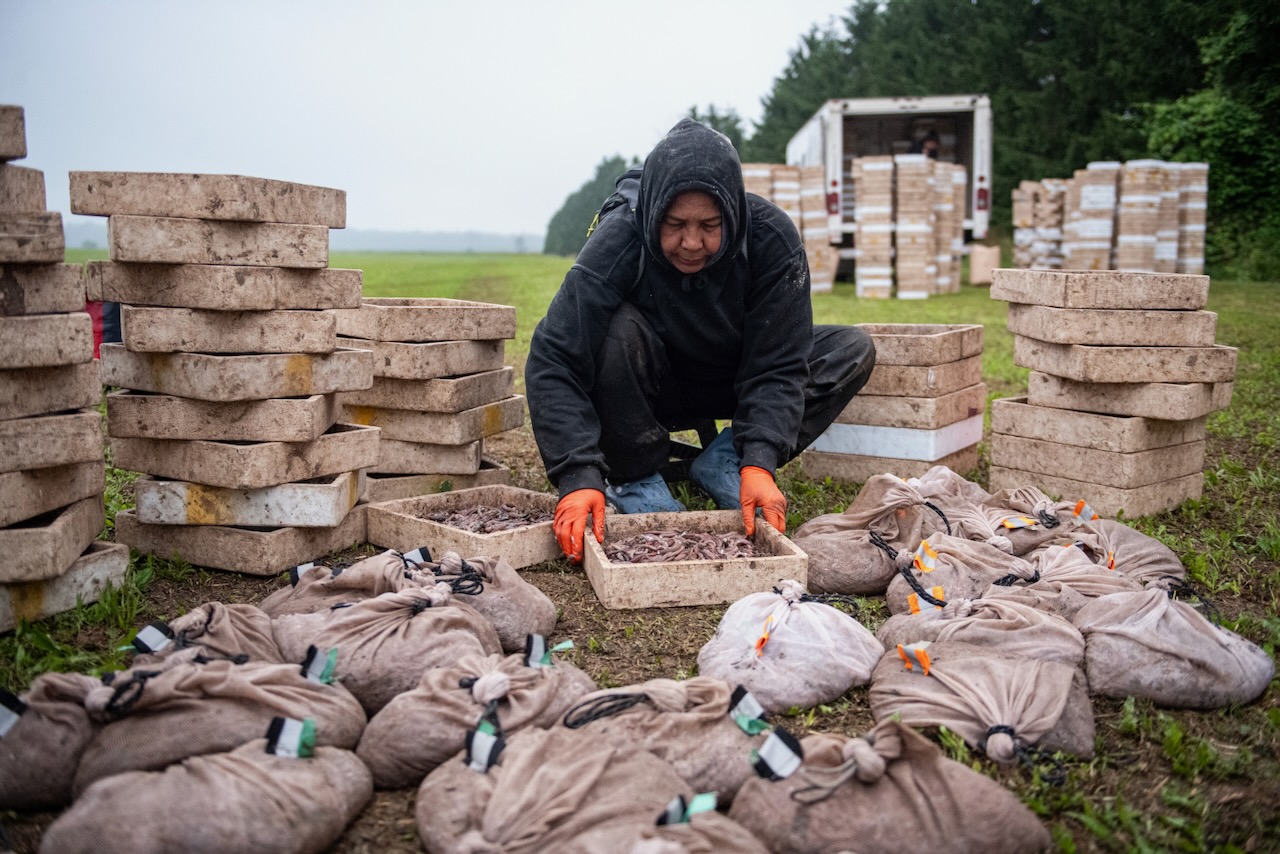
This small corner of Ontario’s economy, so different from anything else the province exports, so unimaginable to city dwellers, is staring down the question of whether it’ll even survive another generation. Mike Balac gives it 10 years, owing primarily to the labour shortages. And in truth, as much as I now have an intense, perhaps overly-romanticized fondness for it, worm harvesting is not an essential industry. The world would move on without it, and it would become a subject of nostalgic memory, a quaint eccentricity from a different time, when people had the luxury of fishing with massive, lively worms hand-selected by workers flown in from the other side of the world.
When Davor shows me the fridge of worms in their warehouse, allowing me to take one in my hand and acquaint myself with the feeling of the curling, slimy mass, a tiny life in my palm, it occurs to me how strange it must be to grow up handling and depending on this creature that most people go out of their way to avoid. “Can I ask you a really weird question?” I preface. “What is your emotional relationship with the worms like?”
He understands the question completely. “I fucking love them,” he says.







